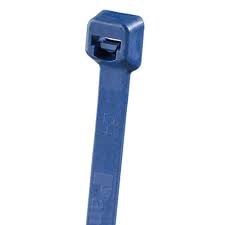Food safety and quality are non-negotiable in today’s manufacturing landscape. For industries governed by Hazard Analysis and Critical Control Points (HACCP) standards, contamination prevention is essential. X-ray detectable cable ties play a vital role in ensuring compliance with these rigorous safety measures, helping to safeguard products, maintain regulatory standards, and protect brand reputation.
What is HACCP Compliance?
HACCP is an internationally recognized system for managing food safety risks. It requires manufacturers to identify critical control points where hazards could compromise product safety and implement preventive measures. Detectable cable ties are a proactive solution, helping to prevent foreign object contamination in sensitive production environments.
Why Detectable Cable Ties Are Essential

X-ray detectable cable ties offer a unique combination of visibility, durability, and compliance, making them indispensable for HACCP-regulated industries.
Key Features That Support HACCP Compliance
- Foreign Object Detectability
These cable ties contain metal particles that make them easily identifiable by X-ray machines and metal detectors, ensuring rapid detection and removal if they enter production lines. - Color Coding for Visual Inspection
A bright blue color, uncommon in food products, enhances visual detection, providing an additional layer of protection. - Durability Under Harsh Conditions
Designed to withstand exposure to extreme temperatures, moisture, and cleaning chemicals, detectable ties maintain their integrity in rigorous environments. - HACCP-Friendly Design
Their construction aligns with HACCP’s preventive approach, reducing contamination risks and ensuring compliance with industry standards.
Applications in Food Manufacturing
Detectable cable ties are widely used in various stages of food production to ensure product integrity and safety. Key applications include:
- Securing Equipment Wiring: Prevents loose cables from contaminating production lines.
- Bundling Ingredients or Components: Keeps items organized while minimizing contamination risks.
- Maintenance in Critical Areas: Detectable ties reduce the likelihood of foreign objects entering the manufacturing process during routine repairs or upgrades.
Learn more: X-Ray Detectable Cable Ties: Long-Term Performance in Extreme Conditions
Advantages of Using Detectable Cable Ties
- Reduced Risk of Product Recalls
Contamination incidents can lead to costly recalls and legal liabilities. Detectable cable ties mitigate these risks by ensuring foreign objects are quickly identified. - Streamlined Audits
Their compliance with HACCP principles simplifies documentation and regulatory audits, giving manufacturers peace of mind. - Enhanced Consumer Trust
Consistently delivering safe, contamination-free products fosters trust and strengthens brand reputation.
Compliance with Global Standards
Detectable cable ties meet international safety and quality standards, including:
- HACCP: Supporting proactive hazard prevention.
- FDA Regulations: Ensuring food-grade materials are used.
- ISO 22000: Aligning with global food safety management systems.
Choosing the Right Detectable Cable Tie
When selecting detectable cable ties for HACCP compliance, consider:
- Detection Compatibility: Ensure compatibility with your detection systems.
- Material and Durability: Opt for ties designed to withstand specific environmental conditions.
- Size and Strength: Match the tie size to your bundling or securing requirements.
Wrapping Up
HACCP compliance demands a proactive approach to food safety, and detectable cable ties provide an essential safeguard against contamination risks. By integrating these ties into their processes, manufacturers can enhance safety, simplify compliance, and protect their brand reputation in a competitive market.
For more insights and tips on cable ties and other related products, explore cabletiesunlimited.com and follow us on our social media communities on Facebook and Instagram!

